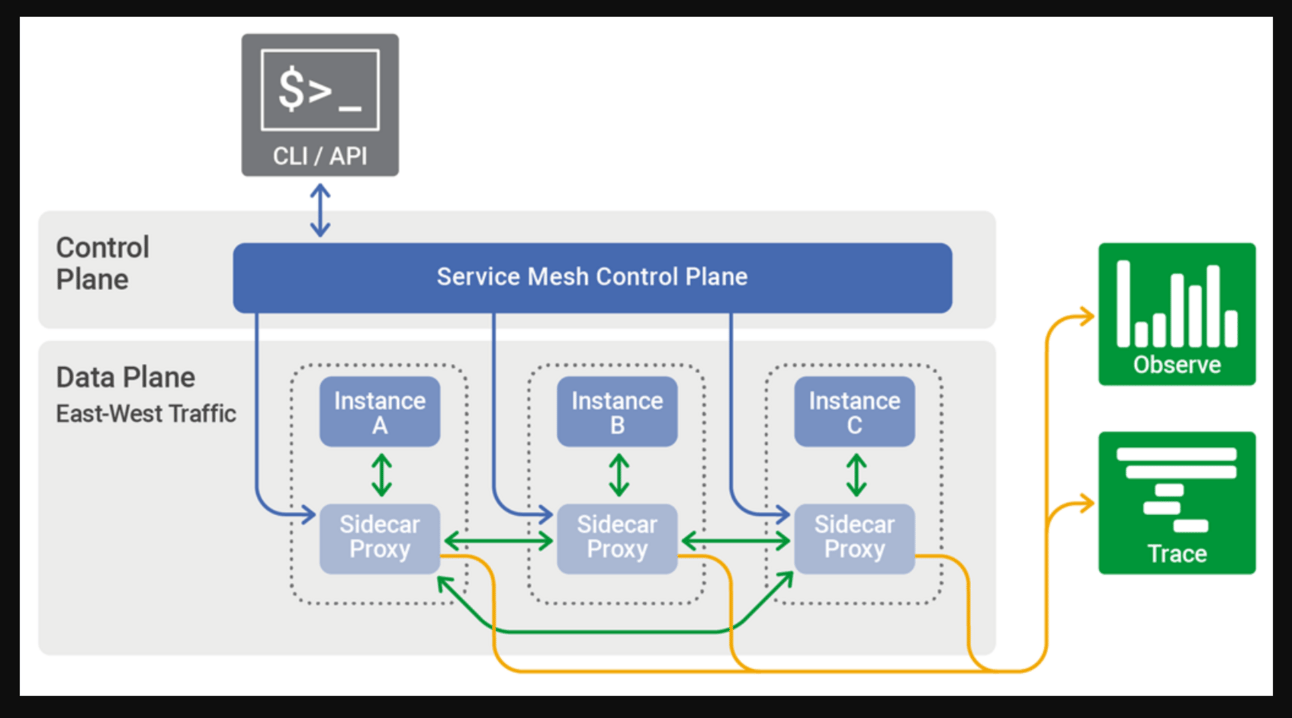Navigate the microservices maze with Service Mesh
Learn the essentials and discover the power of service mesh
Hey there 👋 - Amrut here!
Happy Sunday to all synced with The Tech Pulse!
Microservices are very popular in the tech industry. However, they bring with them a whole new set of complex challenges.
Implementing efficient traffic management, security, and observability within many microservices is no easy task.
Imagine a solution that effortlessly untangles the complexities of service-to-service communication in your microservices architecture.
With Service Mesh, you'll harness the power of enhanced traffic management, security, and observability.
Bridging the gap between complexity and clarity, it redefines your microservices architecture into an efficient, secure, and observable ecosystem.
I have been fascinated by Service Mesh. Hence, in today’s newsletter issue, I plan to share my learnings by discussing the following:
What is a service mesh
Key problems a service mesh solves
Critical components of a service mesh
Overview of popular Service Mesh implementations
Let’s dive in!

Source: Unsplash
What is a Service Mesh?
A service mesh is a dedicated infrastructure layer that facilitates service-to-service communications between microservices, often within a cloud-native application.
It addresses various challenges in a microservice architecture, such as service discovery, load balancing, encryption, observability, and reliability.
Key Problems A Service Mesh Solves
Here are the fundamental problems that service mesh addresses:
Complex Service-to-Service Communication:
In a microservices architecture, the number of inter-service communications can be enormous.
Managing these interactions, ensuring efficient load balancing, and handling failures becomes complex.
A service mesh provides sophisticated routing and load balancing to streamline this communication.
Network Resilience and Reliability
Ensuring reliable communication during partial failures (like network issues or service downtime) is challenging.
Service mesh implements patterns like retries, timeouts, circuit breakers, and backoff policies to enhance the resilience and reliability of the network.
Service Discovery in Dynamic Environments
Microservices environments, especially in cloud and container orchestration platforms like Kubernetes, are highly dynamic, with services frequently scaling up or down.
Service mesh automates the service discovery process, ensuring requests are always routed to the correct and available service instances.
Consistent Implementation of Security Policies
Enforcing security measures like mutual TLS for encrypted communication, access control policies, and ensuring compliance can be cumbersome if handled individually by services.
Service mesh centralizes these security aspects, providing a uniform and consistent approach to securing inter-service communication.
Observability and Monitoring Challenges
Gaining visibility into the performance and interaction of microservices is critical for diagnosing and resolving issues.
Service mesh offers centralized logging, tracing, and metrics collection, providing detailed insights into the health and performance of each microservice.
Configuration and Deployment Complexity
As the number of services grows, managing configurations, deploying updates, and performing canary releases or A/B testing becomes increasingly complex.
A service mesh facilitates these tasks, allowing for more controlled and efficient management of service deployments.
Handling Cross-Cutting Concerns
Concerns like rate limiting, authentication, and authorization are common across services. Implementing these features individually in each service can lead to duplicated efforts and inconsistencies.
A service mesh centralizes the management of these cross-cutting concerns, ensuring uniformity and reducing the development burden.
Policy Enforcement
Enforcing network-level policies across a diverse set of microservices can be difficult.
A service mesh provides a unified layer to enforce policies like rate limiting, quotas, or access controls across all microservices in a consistent manner.
Critical Components of a Service Mesh
A service mesh comprises several vital components that can generally be categorized into two main parts: the data and control planes.

Data Plane
Sidecar Proxies
These are the most critical components in the data plane. A sidecar proxy is deployed alongside each microservice instance, hence the term "sidecar."
These proxies intercept network communication to and from the microservices.
Proxies handle routing, load balancing, health checks, security (like mutual TLS for encryption and authentication), and observability (collecting metrics, logs, and traces).
Control Plane
Management and Configuration Tools
The control plane is responsible for managing and configuring the proxies in the data plane.
It dictates the behavior of the proxies, setting up rules for traffic routing, policies for access control, and configurations for resiliency features like retries and circuit breakers.
Policy Decision Point (PDP)
This is where policies are defined and distributed.
The control plane acts as the source of truth for the configuration and policies that guide the behavior of the sidecar proxies.
Service Discovery
The control plane often integrates with service discovery mechanisms, ensuring that the sidecar proxies know the existence and location of other services within the mesh.
Security Management
It handles security aspects, like managing encryption keys and issuing certificates for mutual TLS, ensuring secure communication between services.
Other Components
API Gateway / Ingress Controller
While not strictly part of the service mesh, in practice, an API Gateway or Ingress Controller is often used in conjunction with a service mesh to manage external traffic entering the mesh.
Observability Tools
Integration with tools like Prometheus for metrics collection and Grafana for data visualization is common in service meshes. These tools help monitor and visualize the health and performance of the services in the mesh.
Popular Service Mesh Implementations
Several service mesh implementations have gained popularity in the industry, each with unique features and strengths.
Here's a brief overview of some of the most well-known service meshes:
1. Istio
Istio is one of the most popular and feature-rich service mesh implementations. It's an open-source project initially developed by Google, IBM, and Lyft.
Istio offers advanced traffic management capabilities, robust security features, including end-to-end authentication and authorization, and detailed metrics, logs, and trace observability. It is known for its extensive control over traffic behavior, including advanced routing, retries, failovers, and fault injection.
Istio is primarily designed to work with Kubernetes but also supports other platforms. It integrates well with existing Kubernetes features and has broad community support.
2. Linkerd
Linkerd is another popular open-source service mesh known for its simplicity and ease of use. It was the first service mesh project created by Buoyant.
Emphasizes minimalism and performance, with a low-resource footprint and straightforward setup. Linkerd provides basic service mesh features like service discovery, load balancing, TLS encryption, and observability.
Linkerd is Kubernetes-native and focuses heavily on simplicity, making it a good choice for those new to service mesh or with simpler use cases.
3. Consul Connect
Consul Connect is part of HashiCorp's Consul, a multi-cloud service networking platform that handles service discovery and configuration.
It offers service segmentation, automatic TLS encryption, and identity-based authorization. Its strength lies in its ability to work across multiple clouds and its integration with the broader Consul platform for service discovery and configuration.
It is not limited to Kubernetes and can be used in various environments, including virtual machines and non-containerized applications.
4. Envoy
Although Envoy is not a complete service mesh solution, it deserves mention as it is the underlying proxy used by several service mesh implementations, including Istio and Consul Connect.
Envoy is a high-performance, extensible proxy designed for modern service-oriented architectures. It offers dynamic service discovery, load balancing, TLS termination, HTTP/2 and gRPC support, and extensive observability.
Envoy is designed to be a universal data plane for a service mesh, and its flexibility and performance make it a popular choice in various environments.
5. AWS App Mesh
AWS App Mesh is a service mesh provided by Amazon Web Services, designed for use within the AWS ecosystem.
It simplifies network traffic management, offers end-to-end encryption, and provides application-level networking. App Mesh integrates seamlessly with AWS services like ECS, EKS, and EC2.
As an AWS-native solution, it’s particularly well-suited for applications heavily integrated with other AWS services and infrastructures.
Key takeaways
Service mesh is not just a tool; it's a transformative approach that addresses some of the most pressing challenges in a microservices environment.
Service mesh emerges as a critical component in the toolkit of developers and organizations embracing microservices.
It offers a comprehensive solution to many of the challenges inherent in distributed systems, paving the way for more efficient, secure, and manageable microservices architectures.
2 Tweets of the week
Whenever you’re ready, there are 3 ways I can help you:
Are you thinking about getting certified as a Google Cloud Digital Leader? Here’s a link to my Udemy course, which has helped 445+ students prepare and pass the exam. Currently, rated 4.89/5. (link)
I have also published a book to help you prepare and pass the Google Cloud Digital Leader exam. You can check it out on Amazon. (link)
Course Recommendation: AWS Courses by Adrian Cantrill (Certified + Job Ready):
AWS Solutions Architect Associate (link)
AWS Developer Associate: (link)
ALL THE THINGS Bundle: (link)
Note: These are affiliate links. That means I get paid a small commission with no additional cost to you. It also helps support this newsletter. 😃
Thank you for investing your time in reading this post.🙏
I'm always looking for topics that resonate with my audience. If there's a specific subject you'd like to know more about or discuss, I welcome you to reply right here.
Please know that each message I receive is read and valued.
Your feedback matters! I genuinely appreciate your thoughts on this issue. Your comments, praise, criticism, and suggestions all play a pivotal role in shaping my content.
Together, we can make this a fruitful and enjoyable exploration of knowledge.
And, if you found value in this newsletter issue and think others might too, it would mean the world to me if you could take a few moments to share it with your loved ones, colleagues, friends, or anyone who might benefit.
Let's keep the conversation going, keep learning, and amplify the power of shared knowledge!

